warning lights BMW 325XI SEDAN 2005 Owners Manual
[x] Cancel search | Manufacturer: BMW, Model Year: 2005, Model line: 325XI SEDAN, Model: BMW 325XI SEDAN 2005Pages: 178, PDF Size: 2.69 MB
Page 18 of 178
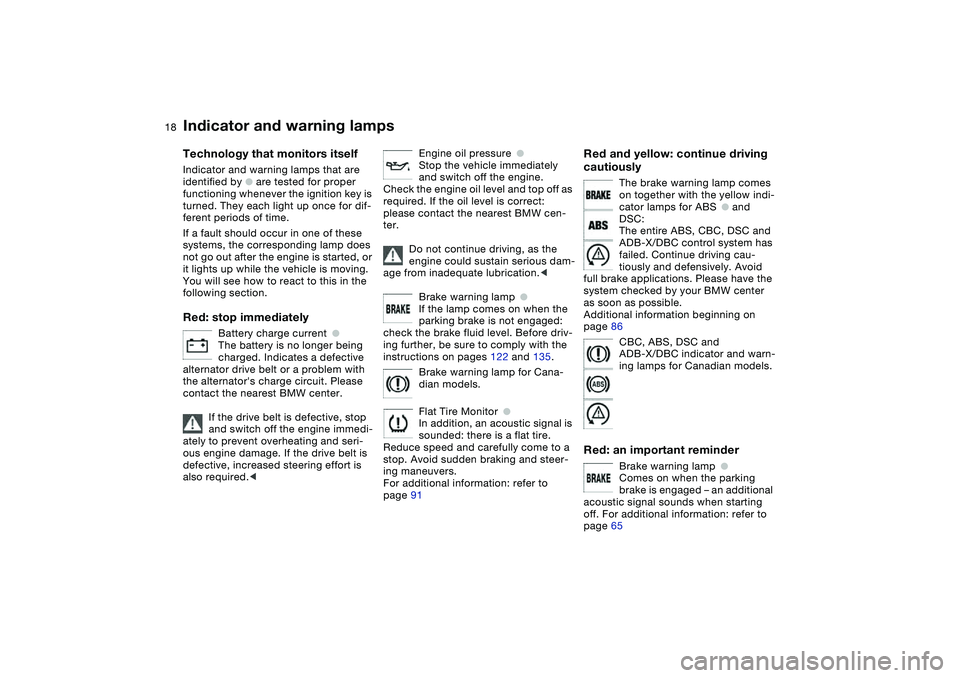
18
Indicator and warning lamps
Technology that monitors itself
Indicator and warning lamps that are
identified by
●
are tested for proper
functioning whenever the ignition key is
turned. They each light up once for dif-
ferent periods of time.
If a fault should occur in one of these
systems, the corresponding lamp does
not go out after the engine is started, or
it lights up while the vehicle is moving.
You will see how to react to this in the
following section.
Red: stop immediately
Battery charge current
●
The battery is no longer being
charged. Indicates a defective
alternator drive belt or a problem with
the alternator's charge circuit. Please
contact the nearest BMW center.
If the drive belt is defective, stop
and switch off the engine immedi-
ately to prevent overheating and seri-
ous engine damage. If the drive belt is
defective, increased steering effort is
also required.
<
Engine oil pressure
●
Stop the vehicle immediately
and switch off the engine.
Check the engine oil level and top off as
required. If the oil level is correct:
please contact the nearest BMW cen-
ter.
Do not continue driving, as the
engine could sustain serious dam-
age from inadequate lubrication.
<
Brake warning lamp
●
If the lamp comes on when the
parking brake is not engaged:
check the brake fluid level. Before driv-
ing further, be sure to comply with the
instructions on pages 122 and 135.
Brake warning lamp for Cana-
dian models.
Flat Tire Monitor
●
In addition, an acoustic signal is
sounded: there is a flat tire.
Reduce speed and carefully come to a
stop. Avoid sudden braking and steer-
ing maneuvers.
For additional information: refer to
page 91
Red and yellow: continue driving
cautiously
The brake warning lamp comes
on together with the yellow indi-
cator lamps for ABS
●
and
DSC:
The entire ABS, CBC, DSC and
ADB-X/DBC control system has
failed. Continue driving cau-
tiously and defensively. Avoid
full brake applications. Please have the
system checked by your BMW center
as soon as possible.
Additional information beginning on
page 86
CBC, ABS, DSC and
ADB-X/DBC indicator and warn-
ing lamps for Canadian models.
Red: an important reminder
Brake warning lamp
●
Comes on when the parking
brake is engaged – an additional
acoustic signal sounds when starting
off. For additional information: refer to
page 65
Page 20 of 178
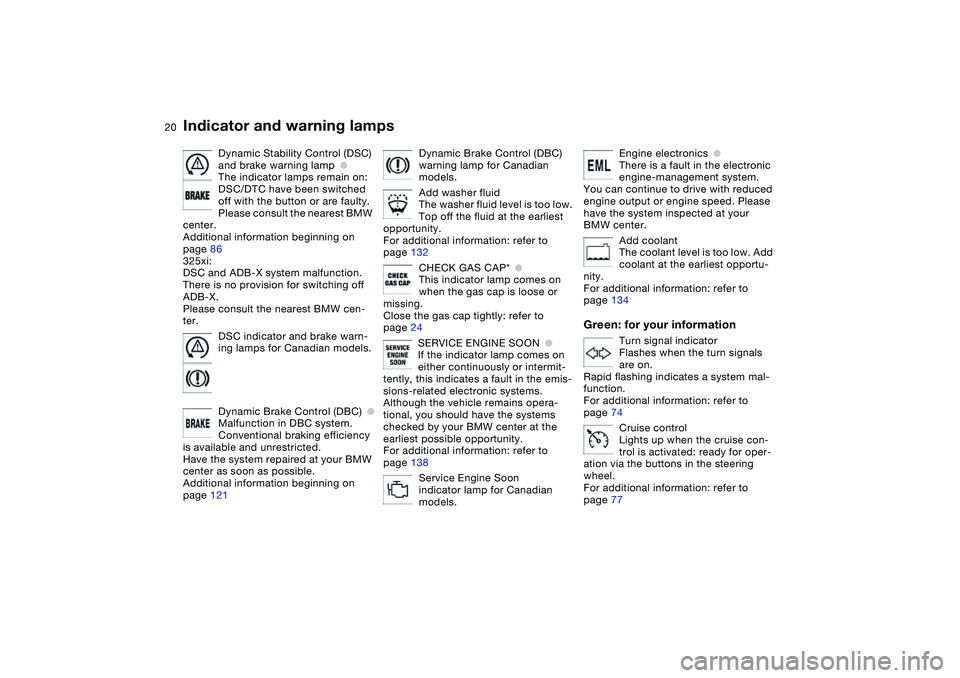
20
Dynamic Stability Control (DSC)
and brake warning lamp
●
The indicator lamps remain on:
DSC/DTC have been switched
off with the button or are faulty.
Please consult the nearest BMW
center.
Additional information beginning on
page 86
325xi:
DSC and ADB-X system malfunction.
There is no provision for switching off
ADB-X.
Please consult the nearest BMW cen-
ter.
DSC indicator and brake warn-
ing lamps for Canadian models.
Dynamic Brake Control (DBC)
●
Malfunction in DBC system.
Conventional braking efficiency
is available and unrestricted.
Have the system repaired at your BMW
center as soon as possible.
Additional information beginning on
page 121
Dynamic Brake Control (DBC)
warning lamp for Canadian
models.
Add washer fluid
The washer fluid level is too low.
Top off the fluid at the earliest
opportunity.
For additional information: refer to
page 132
CHECK GAS CAP*
●
This indicator lamp comes on
when the gas cap is loose or
missing.
Close the gas cap tightly: refer to
page 24
SERVICE ENGINE SOON
●
If the indicator lamp comes on
either continuously or intermit-
tently, this indicates a fault in the emis-
sions-related electronic systems.
Although the vehicle remains opera-
tional, you should have the systems
checked by your BMW center at the
earliest possible opportunity.
For additional information: refer to
page 138
Service Engine Soon
indicator lamp for Canadian
models.
Engine electronics
●
There is a fault in the electronic
engine-management system.
You can continue to drive with reduced
engine output or engine speed. Please
have the system inspected at your
BMW center.
Add coolant
The coolant level is too low. Add
coolant at the earliest opportu-
nity.
For additional information: refer to
page 134
Green: for your information
Turn signal indicator
Flashes when the turn signals
are on.
Rapid flashing indicates a system mal-
function.
For additional information: refer to
page 74
Cruise control
Lights up when the cruise con-
trol is activated: ready for oper-
ation via the buttons in the steering
wheel.
For additional information: refer to
page 77
Indicator and warning lamps
Page 21 of 178
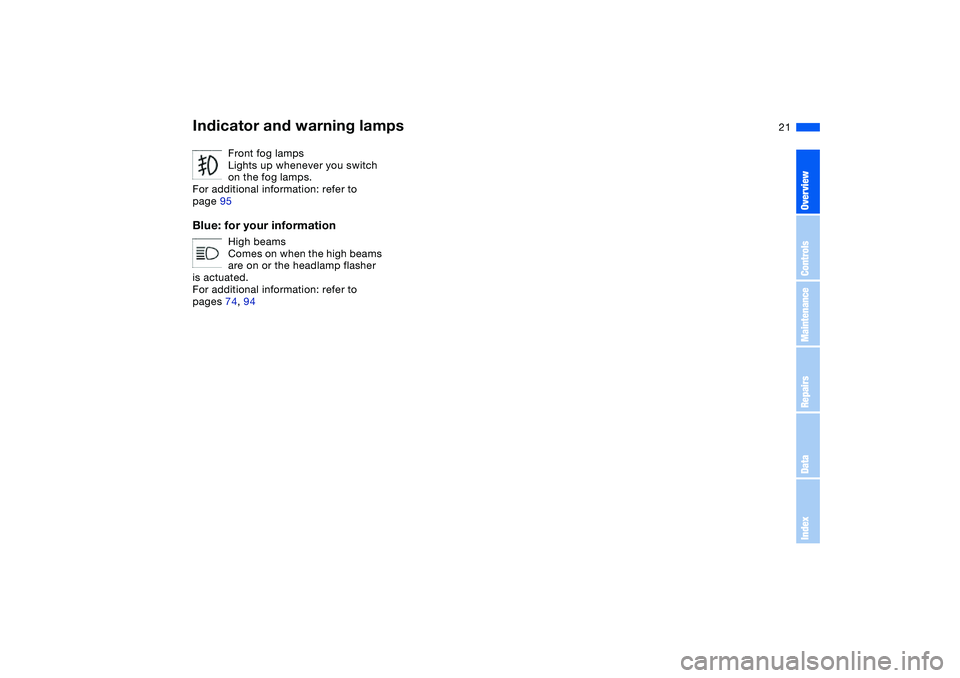
21
Front fog lamps
Lights up whenever you switch
on the fog lamps.
For additional information: refer to
page 95
Blue: for your information
High beams
Comes on when the high beams
are on or the headlamp flasher
is actuated.
For additional information: refer to
pages 74, 94
Indicator and warning lamps
OverviewControlsMaintenanceRepairsDataIndex
Page 80 of 178
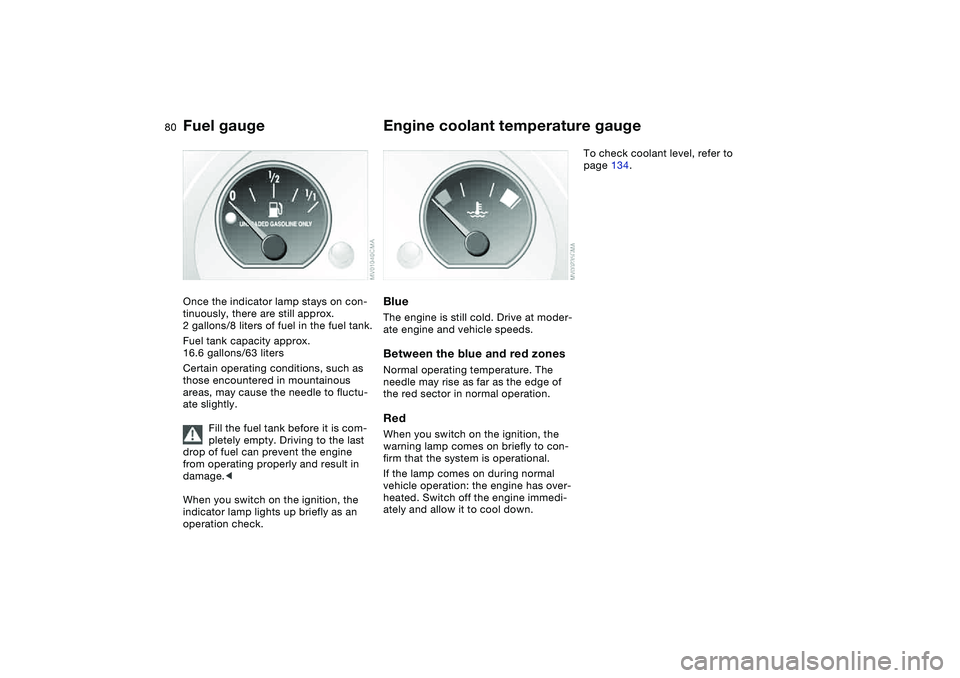
80
Fuel gaugeOnce the indicator lamp stays on con-
tinuously, there are still approx.
2 gallons/8 liters of fuel in the fuel tank.
Fuel tank capacity approx.
16.6 gallons/63 liters
Certain operating conditions, such as
those encountered in mountainous
areas, may cause the needle to fluctu-
ate slightly.
Fill the fuel tank before it is com-
pletely empty. Driving to the last
drop of fuel can prevent the engine
from operating properly and result in
damage.<
When you switch on the ignition, the
indicator lamp lights up briefly as an
operation check.
Engine coolant temperature gaugeBlueThe engine is still cold. Drive at moder-
ate engine and vehicle speeds.Between the blue and red zonesNormal operating temperature. The
needle may rise as far as the edge of
the red sector in normal operation.RedWhen you switch on the ignition, the
warning lamp comes on briefly to con-
firm that the system is operational.
If the lamp comes on during normal
vehicle operation: the engine has over-
heated. Switch off the engine immedi-
ately and allow it to cool down.
To check coolant level, refer to
page 134.
Page 91 of 178
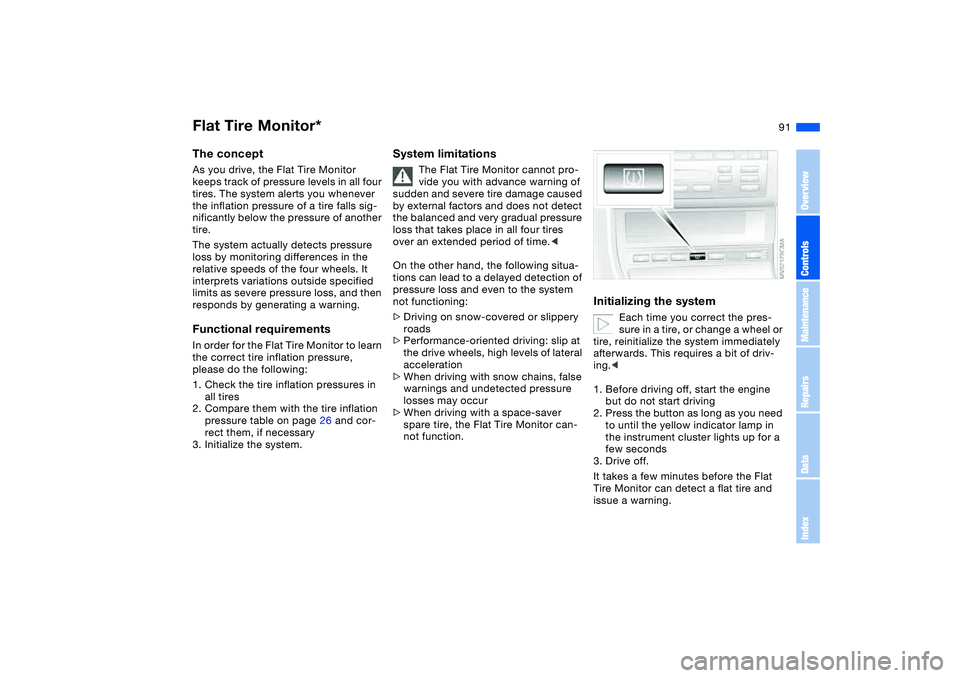
91
Flat Tire Monitor*The conceptAs you drive, the Flat Tire Monitor
keeps track of pressure levels in all four
tires. The system alerts you whenever
the inflation pressure of a tire falls sig-
nificantly below the pressure of another
tire.
The system actually detects pressure
loss by monitoring differences in the
relative speeds of the four wheels. It
interprets variations outside specified
limits as severe pressure loss, and then
responds by generating a warning.Functional requirementsIn order for the Flat Tire Monitor to learn
the correct tire inflation pressure,
please do the following:
1. Check the tire inflation pressures in
all tires
2. Compare them with the tire inflation
pressure table on page 26 and cor-
rect them, if necessary
3. Initialize the system.
System limitations
The Flat Tire Monitor cannot pro-
vide you with advance warning of
sudden and severe tire damage caused
by external factors and does not detect
the balanced and very gradual pressure
loss that takes place in all four tires
over an extended period of time.<
On the other hand, the following situa-
tions can lead to a delayed detection of
pressure loss and even to the system
not functioning:
>Driving on snow-covered or slippery
roads
>Performance-oriented driving: slip at
the drive wheels, high levels of lateral
acceleration
>When driving with snow chains, false
warnings and undetected pressure
losses may occur
>When driving with a space-saver
spare tire, the Flat Tire Monitor can-
not function.
Initializing the system
Each time you correct the pres-
sure in a tire, or change a wheel or
tire, reinitialize the system immediately
afterwards. This requires a bit of driv-
ing.<
1. Before driving off, start the engine
but do not start driving
2. Press the button as long as you need
to until the yellow indicator lamp in
the instrument cluster lights up for a
few seconds
3. Drive off.
It takes a few minutes before the Flat
Tire Monitor can detect a flat tire and
issue a warning.
OverviewControlsMaintenanceRepairsDataIndex
Page 92 of 178
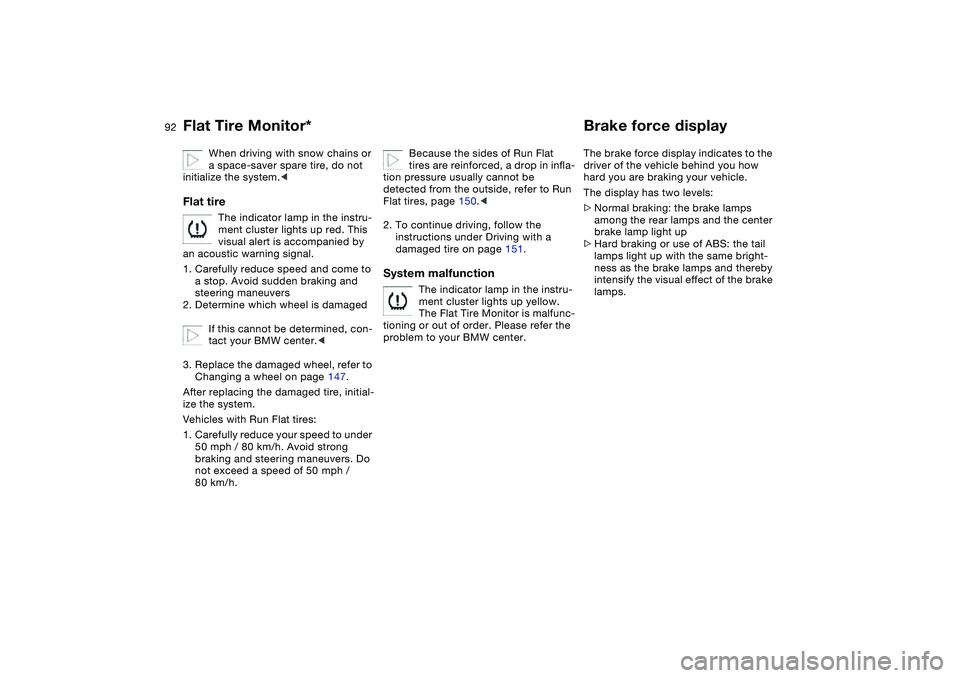
92
When driving with snow chains or
a space-saver spare tire, do not
initialize the system.<
Flat tire
The indicator lamp in the instru-
ment cluster lights up red. This
visual alert is accompanied by
an acoustic warning signal.
1. Carefully reduce speed and come to
a stop. Avoid sudden braking and
steering maneuvers
2. Determine which wheel is damaged
If this cannot be determined, con-
tact your BMW center.<
3. Replace the damaged wheel, refer to
Changing a wheel on page 147.
After replacing the damaged tire, initial-
ize the system.
Vehicles with Run Flat tires:
1. Carefully reduce your speed to under
50 mph / 80 km/h. Avoid strong
braking and steering maneuvers. Do
not exceed a speed of 50 mph /
80 km/h.
Because the sides of Run Flat
tires are reinforced, a drop in infla-
tion pressure usually cannot be
detected from the outside, refer to Run
Flat tires, page 150.<
2. To continue driving, follow the
instructions under Driving with a
damaged tire on page 151.
System malfunction
The indicator lamp in the instru-
ment cluster lights up yellow.
The Flat Tire Monitor is malfunc-
tioning or out of order. Please refer the
problem to your BMW center.
Brake force displayThe brake force display indicates to the
driver of the vehicle behind you how
hard you are braking your vehicle.
The display has two levels:
>Normal braking: the brake lamps
among the rear lamps and the center
brake lamp light up
>Hard braking or use of ABS: the tail
lamps light up with the same bright-
ness as the brake lamps and thereby
intensify the visual effect of the brake
lamps.
Flat Tire Monitor*
Page 93 of 178
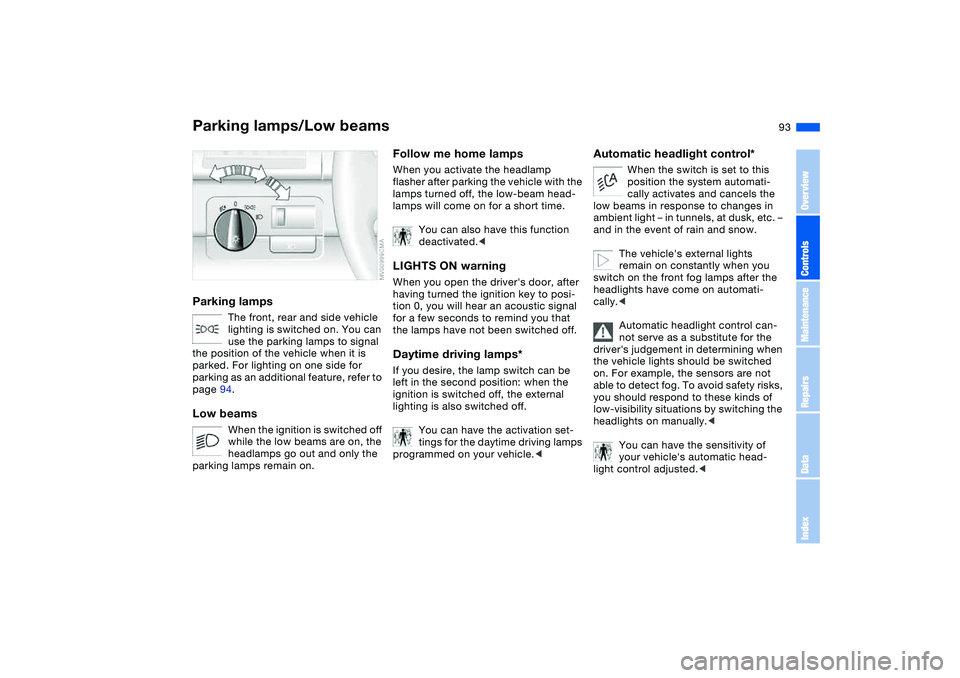
93 Lamps
Parking lamps/Low beamsParking lamps
The front, rear and side vehicle
lighting is switched on. You can
use the parking lamps to signal
the position of the vehicle when it is
parked. For lighting on one side for
parking as an additional feature, refer to
page 94.
Low beams
When the ignition is switched off
while the low beams are on, the
headlamps go out and only the
parking lamps remain on.
Follow me home lampsWhen you activate the headlamp
flasher after parking the vehicle with the
lamps turned off, the low-beam head-
lamps will come on for a short time.
You can also have this function
deactivated.
tion 0, you will hear an acoustic signal
for a few seconds to remind you that
the lamps have not been switched off.Daytime driving lamps*If you desire, the lamp switch can be
left in the second position: when the
ignition is switched off, the external
lighting is also switched off.
You can have the activation set-
tings for the daytime driving lamps
programmed on your vehicle.<
Automatic headlight control*
When the switch is set to this
position the system automati-
cally activates and cancels the
low beams in response to changes in
ambient light – in tunnels, at dusk, etc. –
and in the event of rain and snow.
The vehicle's external lights
remain on constantly when you
switch on the front fog lamps after the
headlights have come on automati-
cally.<
Automatic headlight control can-
not serve as a substitute for the
driver's judgement in determining when
the vehicle lights should be switched
on. For example, the sensors are not
able to detect fog. To avoid safety risks,
you should respond to these kinds of
low-visibility situations by switching the
headlights on manually.<
You can have the sensitivity of
your vehicle's automatic head-
light control adjusted.<
OverviewControlsMaintenanceRepairsDataIndex
Page 167 of 178
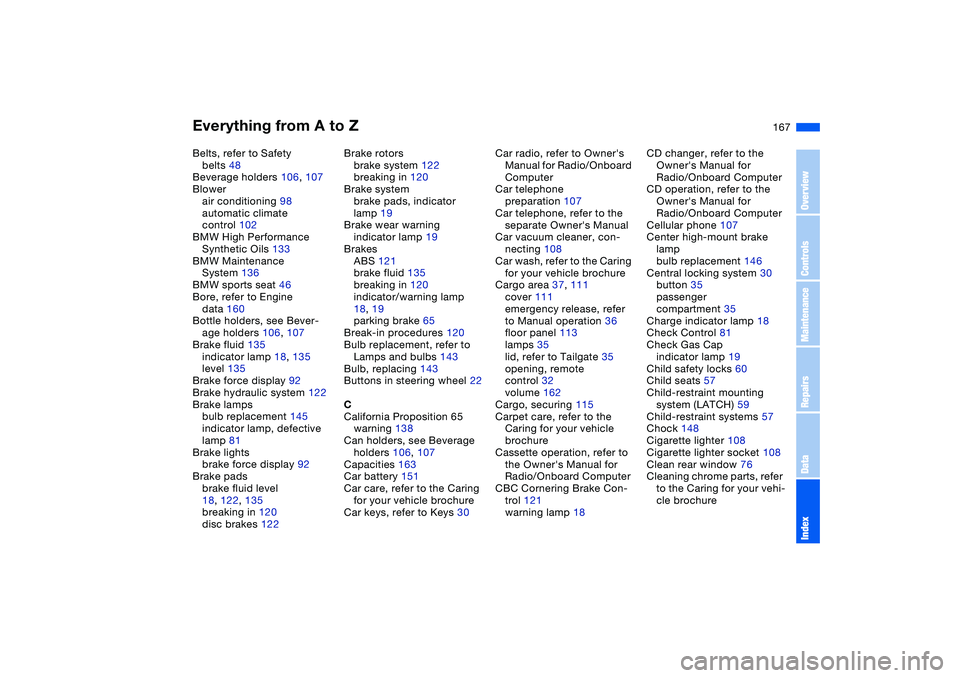
Everything from A to Z
167
Belts, refer to Safety
belts 48
Beverage holders 106, 107
Blower
air conditioning 98
automatic climate
control 102
BMW High Performance
Synthetic Oils 133
BMW Maintenance
System 136
BMW sports seat 46
Bore, refer to Engine
data 160
Bottle holders, see Bever-
age holders 106, 107
Brake fluid 135
indicator lamp 18, 135
level 135
Brake force display 92
Brake hydraulic system 122
Brake lamps
bulb replacement 145
indicator lamp, defective
lamp 81
Brake lights
brake force display 92
Brake pads
brake fluid level
18, 122, 135
breaking in 120
disc brakes 122Brake rotors
brake system 122
breaking in 120
Brake system
brake pads, indicator
lamp 19
Brake wear warning
indicator lamp 19
Brakes
ABS 121
brake fluid 135
breaking in 120
indicator/warning lamp
18, 19
parking brake 65
Break-in procedures 120
Bulb replacement, refer to
Lamps and bulbs 143
Bulb, replacing 143
Buttons in steering wheel 22
C
California Proposition 65
warning 138
Can holders, see Beverage
holders 106, 107
Capacities 163
Car battery 151
Car care, refer to the Caring
for your vehicle brochure
Car keys, refer to Keys 30Car radio, refer to Owner's
Manual for Radio/Onboard
Computer
Car telephone
preparation 107
Car telephone, refer to the
separate Owner's Manual
Car vacuum cleaner, con-
necting 108
Car wash, refer to the Caring
for your vehicle brochure
Cargo area 37, 111
cover 111
emergency release, refer
to Manual operation 36
floor panel 113
lamps 35
lid, refer to Tailgate 35
opening, remote
control 32
volume 162
Cargo, securing 115
Carpet care, refer to the
Caring for your vehicle
brochure
Cassette operation, refer to
the Owner's Manual for
Radio/Onboard Computer
CBC Cornering Brake Con-
trol 121
warning lamp 18CD changer, refer to the
Owner's Manual for
Radio/Onboard Computer
CD operation, refer to the
Owner's Manual for
Radio/Onboard Computer
Cellular phone 107
Center high-mount brake
lamp
bulb replacement 146
Central locking system 30
button 35
passenger
compartment 35
Charge indicator lamp 18
Check Control 81
Check Gas Cap
indicator lamp 19
Child safety locks 60
Child seats 57
Child-restraint mounting
system (LATCH) 59
Child-restraint systems 57
Chock 148
Cigarette lighter 108
Cigarette lighter socket 108
Clean rear window 76
Cleaning chrome parts, refer
to the Caring for your vehi-
cle brochure
OverviewControlsMaintenanceRepairsDataIndex
Page 171 of 178
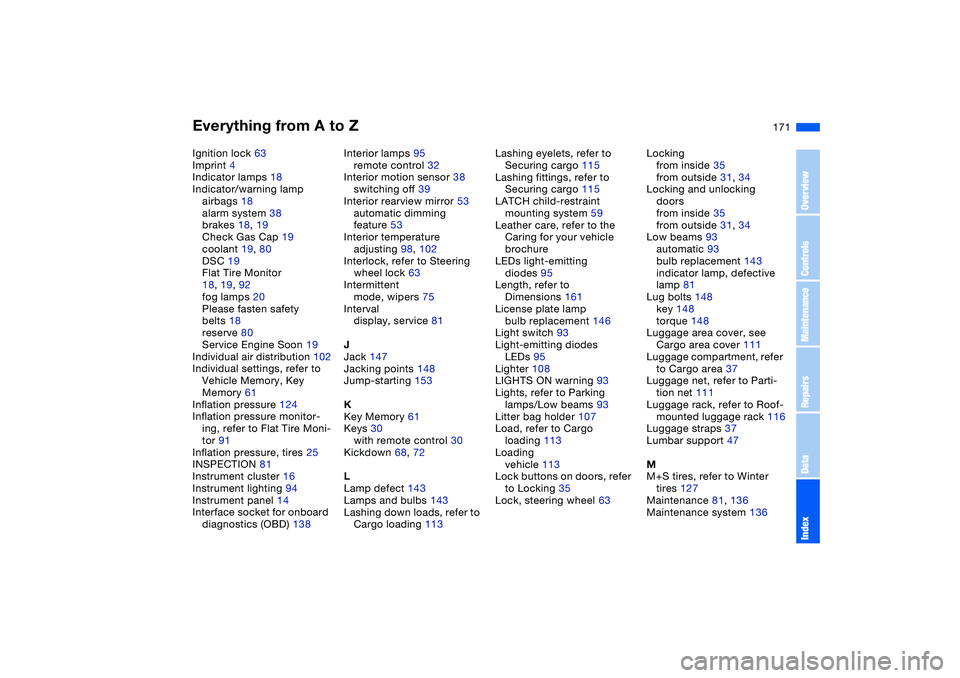
Everything from A to Z
171
Ignition lock 63
Imprint 4
Indicator lamps 18
Indicator/warning lamp
airbags 18
alarm system 38
brakes 18, 19
Check Gas Cap 19
coolant 19, 80
DSC 19
Flat Tire Monitor
18, 19, 92
fog lamps 20
Please fasten safety
belts 18
reserve 80
Service Engine Soon 19
Individual air distribution 102
Individual settings, refer to
Vehicle Memory, Key
Memory 61
Inflation pressure 124
Inflation pressure monitor-
ing, refer to Flat Tire Moni-
tor 91
Inflation pressure, tires 25
INSPECTION 81
Instrument cluster 16
Instrument lighting 94
Instrument panel 14
Interface socket for onboard
diagnostics (OBD) 138Interior lamps 95
remote control 32
Interior motion sensor 38
switching off 39
Interior rearview mirror 53
automatic dimming
feature 53
Interior temperature
adjusting 98, 102
Interlock, refer to Steering
wheel lock 63
Intermittent
mode, wipers 75
Interval
display, service 81
J
Jack 147
Jacking points 148
Jump-starting 153
K
Key Memory 61
Keys 30
with remote control 30
Kickdown 68, 72
L
Lamp defect 143
Lamps and bulbs 143
Lashing down loads, refer to
Cargo loading 113Lashing eyelets, refer to
Securing cargo 115
Lashing fittings, refer to
Securing cargo 115
LATCH child-restraint
mounting system 59
Leather care, refer to the
Caring for your vehicle
brochure
LEDs light-emitting
diodes 95
Length, refer to
Dimensions 161
License plate lamp
bulb replacement 146
Light switch 93
Light-emitting diodes
LEDs 95
Lighter 108
LIGHTS ON warning 93
Lights, refer to Parking
lamps/Low beams 93
Litter bag holder 107
Load, refer to Cargo
loading 113
Loading
vehicle 113
Lock buttons on doors, refer
to Locking 35
Lock, steering wheel 63Locking
from inside 35
from outside 31, 34
Locking and unlocking
doors
from inside 35
from outside 31, 34
Low beams 93
automatic 93
bulb replacement 143
indicator lamp, defective
lamp 81
Lug bolts 148
key 148
torque 148
Luggage area cover, see
Cargo area cover 111
Luggage compartment, refer
to Cargo area 37
Luggage net, refer to Parti-
tion net 111
Luggage rack, refer to Roof-
mounted luggage rack 116
Luggage straps 37
Lumbar support 47
M
M+S tires, refer to Winter
tires 127
Maintenance 81, 136
Maintenance system 136
OverviewControlsMaintenanceRepairsDataIndex